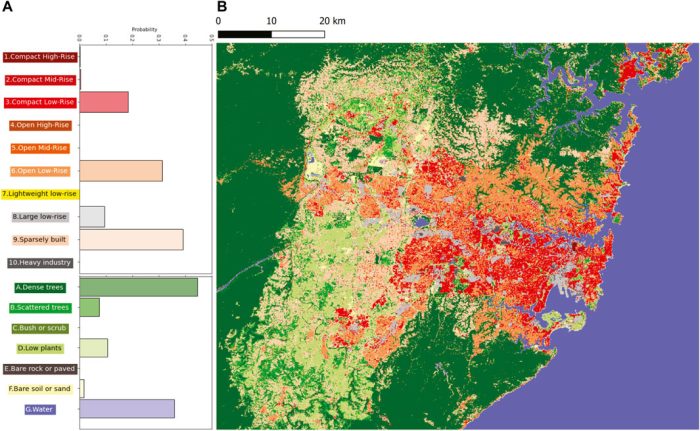
In a world first, Centre postdoctoral researcher Dr Mat Lipson and colleagues partnered with Australian companies AURIN and Geoscape to transform the way cities can be integrated in weather and climate models. The research was enabled by a new generation of sub-metre urban morphology data sets covering entire continents and powered by machine learning, satellite imagery and remote sensing. From these new data sets they could, for the first time, configure our urban climate models across large geographical extents with unparalleled accuracy, from the ‘bottom-up’. AURIN and Geoscape are the developers of the only continental-scale building-resolving data set available in the world, which includes the shape and height of every building in Australia larger than nine square metres (a small bedroom), as well as the land cover of all Australian urban areas at two-metre resolution.
From this valuable Geoscape data the collaborators derived new data sets for Sydney and Melbourne, with 25 parameters used to configure slab, canyon or block-array urban land surface models. We negotiated with Geoscape to make the derived Sydney data openly available at 300-metre resolution, which makes it suitable for high-resolution urban climate modelling.
This bottom-up approach is in stark contrast to the top-down or class-based methods traditionally used to configure urban models since the beginning of the field 50 years ago. The authors compare the latest top-down methods (for example, the 10-class Local Climate Zones) with their bottom-up approach, and they provide tables of adjusted parameter values that are more appropriate for modelling, using classes in Australian cities. They discuss the future of top-down versus bottom-up methods of configuring urban models and predict that bottom-up will come to replace top-down as consistent building-resolving data sets become more widely available globally in coming years.
Lipson, M.J., Nazarian, N., Hart, M.A., Nice, K.A., Conroy, B., 2022. A transformation in city-descriptive input data for urban climate models. Frontiers in Environmental Science 10, 866398. https://doi.org/10.3389/fenvs.2022.866398
